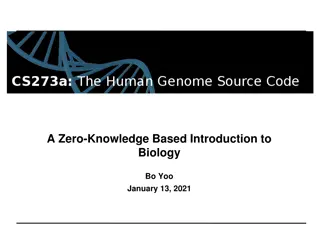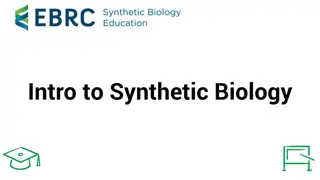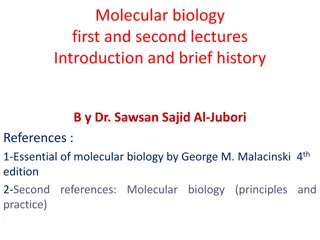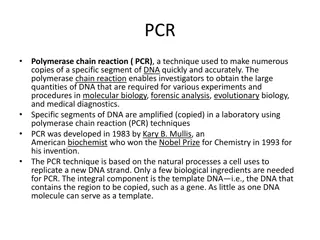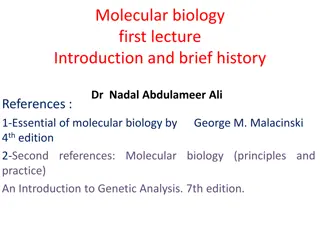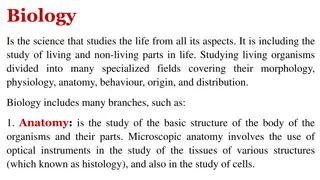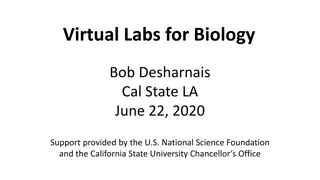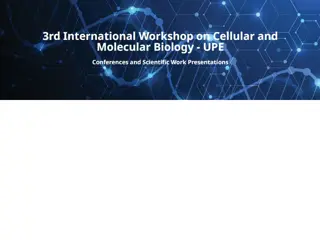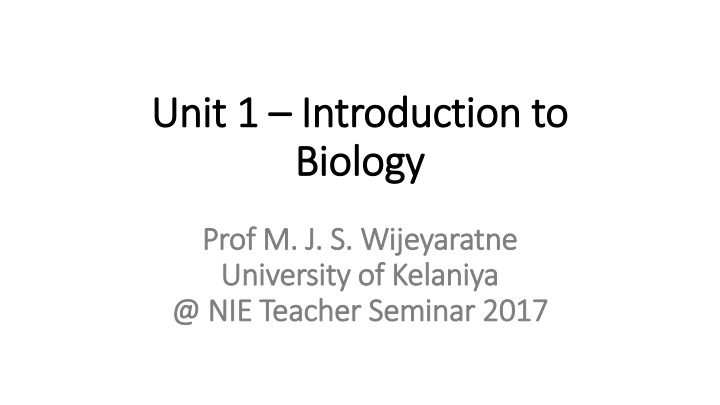
Competency Level 1.1.1 in Biology Education
Explore the nature, scope, and importance of biology, along with challenges faced by mankind. Delve into issues of biological diversity, human body functions, plant life, and more. Learn to appreciate biology as a multidisciplinary subject and how challenges are overcome using new technologies.
Uploaded on | 1 Views
Download Presentation

Please find below an Image/Link to download the presentation.
The content on the website is provided AS IS for your information and personal use only. It may not be sold, licensed, or shared on other websites without obtaining consent from the author. If you encounter any issues during the download, it is possible that the publisher has removed the file from their server.
You are allowed to download the files provided on this website for personal or commercial use, subject to the condition that they are used lawfully. All files are the property of their respective owners.
The content on the website is provided AS IS for your information and personal use only. It may not be sold, licensed, or shared on other websites without obtaining consent from the author.
E N D
Presentation Transcript
Unit 1 Unit 1 Introduction to Introduction to Biology Biology Prof M. J. S. Prof M. J. S. Wijeyaratne University of Kelaniya University of Kelaniya @ NIE Teacher Seminar 2017 @ NIE Teacher Seminar 2017 Wijeyaratne
Aims: Aims: At the end of the course, students will be able to: develop an interest and desire to expand and deepen knowledge in Biology. understand the concepts, phenomena principles and processes in Biology through collaborative learning practices adjudicate our place in nature, understand our interrelations and impact on the natural and social environment develop the ability to plan investigations, and solve problems in Biology Develop a sense of belonging to the environment and identify the country s natural habitats, together with a positive attitude towards fauna and flora, in order to foster responsibility and involvement in preserving and protecting nature and the quality of the environment. Develop sensitivity to current practical problems of everyday life. Develop an awareness of good habits for maintaining hygiene, health and quality of life.
Competency level 1 Competency level 1.1.1: Elaborates on the nature, scope and .1.1: Elaborates on the nature, scope and importance of biology with reference to challenges faced by importance of biology with reference to challenges faced by the mankind the mankind Contents: Nature, Scope and importance of biology Issues pertaining to biology Understanding biological diversity Understanding the human body and its functions Understanding plant life Management of natural resources and environment Sustainable food production Understanding of diseases and causes Legal and ethical issues
Learning outcomes for competency level 1.1.1 Learning outcomes for competency level 1.1.1 Students should be able to : describe the nature, scope and importance of biology, discuss the issues and challenges faced by mankind with reference to biology, discuss how challenges are overcome using new technologies and appreciate the study of biology as a multidisciplinary subject.
What to teach in two periods ? What to teach in two periods ?
Nature, scope and importance of Biology: Nature, scope and importance of Biology: Biology is a branch of science that deals with the study of life. Scientific study of life. (What is life? The condition that distinguishes animals, plants and microorganisms from inorganic matter. This includes capacity for growth, reproduction, functional activity, and continual change). Biology helps to know about the diversity in the living world, the ways by which it can be conserved, more about ourselves. Biology is a vast field. It includes the study of various aspects of living organisms and their interactions with the non-living components. Biology has three primary branches Botany (the study of plants), Zoology (the study of animals) and Microbiology (the study of microorganisms)
Nature, scope and importance of Biology Nature, scope and importance of Biology Contd. Some areas of study in these branches: Taxonomy (classification), Morphology (study of external form), Anatomy (study of internal structure), Histology (study of tissues), Cell Biology (Study of cells), Genetics (study of how characters pass to the next generation), Physiology (study of how the animals and plant function) etc. Interdisciplinary branches indicate the relationship of Biology with other branches of science. Some common interdisciplinary branches are Biophysics, Biochemistry, Biometry and Bioinformatics. Psychology and Sociobiology are interdisciplinary branches involving Biology and Social Sciences. Applied branches enable us to apply the knowledge gained from different areas to be used for welfare of man, animals and plants. These include branches like Agriculture, Animal husbandry, Aquaculture, Entomology, Aquaculture, Food technology and Biotechnology. Contd.
Nature, scope and importance of Biology Nature, scope and importance of Biology Contd. Contd. Biology is important to everyday life in many ways. It helps to understand how our body is made, how it functions and how it could be maintained in a healthy manner it helps to understand the resources we use and potential threats to those resources it helps to understand our environment we live, threats to our environment and how we could conserve our environment. it helps to understand how life originated on earth and how it has evolved over time. it helps to understand how the characters pass from generation to generation. It helps to improve our health It helps to increase food production
Issues pertaining to Biology: Issues pertaining to Biology: Understanding Biological Diversity Biological Diversity :The variety of life on earth; The number of species of plants, animals, and microorganisms, the diversity of genes in these species, the different ecosystems on the planet, such as deserts, rainforests and coral reefs are all part of a biologically diverse Earth. Diversity of these is huge Hence, it is very difficult to understand all of them Number of species on earth: Estimated Number: 10 -100 million Described and catalogued: 1.2 million Number of genes in humans: 19,000-20,000 Number of ecosystems: An ecosystem includes all of the living things (plants, animals and microorganisms) in a given area, interacting with each other, and also with their non-living environments : How many ??? How challenges could be overcome by new technologies?: Molecular Biology, genetic engineering,
Issues pertaining to Biology Issues pertaining to Biology - - Contd. Understanding the human body and how it functions Many thing are not known yet. New research is continuously being done; understand what triggers ageing, how cancer originates, how it can be suppressed/controlled, how brain works, the interrelationship between an individual s characteristics (phenotype) and its DNA sequence, - Use of molecular Biology, Nanotechnology, Biophysics, DNA Technology Understanding the plant life Many are not known about plant life too. How plants function? How they synthesize various material in their bodies? Contd. How challenges are over come by new technologies?: Use of molecular Biology, Nanotechnology, Biophysics, DNA Technology
Issues pertaining to Biology Issues pertaining to Biology - - Contd. Management of natural resources and environment Very important issue Must fill existing gaps in our understanding of the processes that produce biodiversity and contribute to its loss, and to gain a fundamental understanding of how diversity affects productivity, and invasive ability of certain species and anthropogenic impacts How utilization of natural resources could be managed to get the benefits in a sustainable manner How environment could be managed How degraded environments could be restored (Discuss with current information) What are the current environmental issues and how they could be solved/mitigated. Use of Bioinformatics - an interdisciplinary field that develops methods and software tools for understanding biological data. It combines computer science, statistics, mathematics, and engineering to analyze and interpret biological data. Contd.
Issues pertaining to Biology Issues pertaining to Biology - - Contd. Sustainable food production Human population is ever increasing Environment is getting degraded How these affect food production? How Biology can contribute to increase food production? Improving the quality of the soil by biological methods e.g. Using microorganisms - Biotechnology Improving the productivity of plants and animals that are used as food: Breeding techniques, Genetical improvement Genetic engineering, molecular biology Reducing losses due to pests and diseases or in storage. Sustainability is also important in food production the methods that are used must be useful for many future generations rather than for few seasons. Sustainability includes reducing the carbon footprint of the farming methods also. The amount of carbon dioxide released into the atmosphere as a result of the activities of a particular individual, organization, or community. Use of Biotechnology Give examples; Nanotechnology - nanocapsules containing herbicides; bionanosensors Contd.
Issues pertaining to Biology Issues pertaining to Biology - - Contd. Understanding diseases and causes Emerging diseases Give some current examples Leishmaniasis - caused by the protozoan Leishmania parasites which are transmitted by sand flies. Dengue Dengue virus Transmitted by Aedis aegyptii and Aedis albopictus change in feeding pattern Use of Biotechnology CKDu Where distributed Reasons? Use of Bioinformatics, Computational Biology Cancer Many research is being done - Use of Nanomedicine Nanorobots Legal and ethical issues Give current examples where modern technology in Biology has been used in legal matters Identifying criminals, paternity tests Ethical issues in Biology Discuss giving examples; killing animals for research, asking highly personal questions in research, Killing endangered animals for research, etc., How challenges could be overcome by new technologies?: DNA Technology etc. Contd.
Competency Level 1.1.2.: Reviews the nature Competency Level 1.1.2.: Reviews the nature and organizational patterns of the living world and organizational patterns of the living world Contents Diversity of organisms size, shape, form, habitat Characteristics of organisms Order and organization Metabolism Growth and development Irritability and coordination Adaptation Reproduction Heredity and evolution
Competency Level 1.1.2.: Reviews the nature and Competency Level 1.1.2.: Reviews the nature and organizational patterns of the living world organizational patterns of the living world Contd. Contd. Contents: Contd. Hierarchical levels of organization of living things Molecules Organelles Cells Tissues Organs Organ systems Organism Population Community Ecosystem Biosphere Cell as the basic structural and functional unit of life
Learning outcomes for competency level 1.1.2: Learning outcomes for competency level 1.1.2: Student should be able to: discuss the wide range in shapes, sizes , forms and habitats of living organisms elaborate characteristics of living organisms construct the hierarchical levels of organization with suitable examples justify the cell as the basic structural and functional unit of life appreciate all kind of organisms and their interactions
What to teach in three periods ? What to teach in three periods ?
Diversity of organisms Diversity of organisms - - Size, shape, form, habitat Size, shape, form, habitat Give the sizes of organisms of different groups: Microbes Blue whale Size ranges of different groups: Viruses Bacteria Fungi plants Animals State the shapes Indicate the shapes of microscopic organisms Give examples Also indicate that some do not have a definite shape Give examples Variation of shape of animals Get examples from students
Body form and habitat Body form and habitat Variation of body form- Get examples from students and relate those to the habitat : Fish & Birds Spindle shape (fusiform) to reduce friction while moving: Snakes: Long slender body: to creep Elephant: Trunk, large legs - for what? Horse: Narrow body and long slender legs with reduced number of digits Whale and any other marine mammal- ????? Show pictures Give some more examples to make the lecture interesting. Let the students think how body form is related to their habitat.
Characteristics of Living organisms Describe the characteristics given in the syllabus Order and organization Metabolism Growth and development Irritability and coordination Adaptation Reproduction Heredity and evolution
Order and organization Order: Illustrate the highly ordered structure of life. Take a suitable example (e.g. A flower) Organization: Living organisms have a high organization also. show the different levels of organization from molecules to organism level. Briefly describe these. Molecules Organelles Cells Tissues Organs Organ systems Organism
Metabolism Metabolism Metabolism is the term used to describe all chemical reactions involved in maintaining the living state of the cells and the organism. Metabolism: two categories: Catabolism - the breakdown of molecules to obtain energy Anabolism - the synthesis of all compounds needed by the cells using energy Metabolism is linked to nutrition and availability of nutrients. Take a suitable example: e.g. butterfly obtains fuel in the form of nectar from flowers. The butterfly use chemical energy stored in its food to provide energy for flight and other work.
Growth and development Growth and development Cell division - the orderly formation of new cells. Cell enlargement - the increase in size of a cell. Cells grow to a certain size and then divide. An organism gets larger as the number and size of its cells increases. Inherited information carried by genes controls the pattern of growth and development of organisms.
Irritability and coordination What is irritability ? The excitatory ability that living organisms have, to respond to changes in their environment What is coordination? The ability to use different parts of the body together smoothly and efficiently. This is needed to maintain internal environment in an optimum condition Homeostasis; and also to regulate the activities of the body. Explain giving suitable example. The regulation of blood flow through the blood vessels of the ears of some mammals (e.g. Elephant) helps to maintain a constant body temperature by adjusting heat exchange with the surrounding air.
Adaptation Camouflaging of the animal in its environment. Give some local examples; Show pictures. Adaptation predatory life leopard, Tuna Adaptation to gather food and ingest - Elephant Adaptation to flight - Such adaptations evolve over many generations by the reproductive success of those individuals with heritable traits that are best suited to their environments.
Reproduction Ability to produce its own kind
Heredity and Evolution Explain Heredity: The transmission of traits (genetic characters) from one generation to the next Explain with examples Evolution:Descent with modification; the idea that living species are descendants of ancestral species that were different from the present- day ones; also defined as the change in the genetic composition of a population from generation to generation Explain with examples
Hierarchical levels of organization of living things Molecules Organelles Cells Tissues Organs Organ systems Organism Population Community Ecosystem Biosphere Describe with suitable examples; Examples may be obtained from students also. Cell as the basic structural and functional unit of life

![❤[READ]❤ Cosmic Biology: How Life Could Evolve on Other Worlds (Springer Praxis](/thumb/21556/read-cosmic-biology-how-life-could-evolve-on-other-worlds-springer-praxis.jpg)



